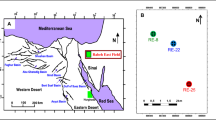Abstract
The present study makes an attempt to utilize reservoir parameters which have been integrated into Arc GIS to delineate hydrocarbon potential zones in Masila oil field, Yemen. Petrophysical analysis has been carried out for a set of well logs data using Schlumberger Techlog software. Reservoir parameters calculated from well logs analysis include effective porosity (PHIE), permeability (K), Net-Pay thickness (N-PTh), hydrocarbon saturation (Sh), water saturation (Swe), the volume of shale (Vsh), and fault system (Fs). Petrophysical parameters prepared as contour maps, converted into raster format, classified and visualized as 2D/3D on GIS platform. Frequency ration model has been used to assess weighting score for each parameter with the help of existing wells location. Themes of reservoir parameters are reclassified by using weightage score of frequency ratio model. The result obtained from analyses of reservoir properties concluded that total effective porosity ranges between 17 and 38%, permeability between 108.89 and 903.30 mD, net-pay thickness 25–189.30 m, volume of shale 9–27%, water saturation 14–77%, and hydrocarbon saturation 73–86%, which is mostly concentrated in NW and SW in the study area. These parts of oil field reveal promising reservoir characteristics and have more hydrocarbon potential due to high values of permeability, porosity, and hydrocarbon saturation and less values of water saturation and volume of shale. The area is categorized into five potential zones, viz., very high, high, moderate, low, and very low. Reservoir cross plots of hydrocarbon occurrence have been used to validate the new potential zones. The result of overlay has shown very good correlation with the present ground situation. The outcome of this research will contribute to the development of the existing oil fields; besides, it will provide a superior database and will lead to improvement in decision-making to achieve higher hydrocarbon exploration and production.














Similar content being viewed by others
References
Adaeze IU, Onyekuru S, Iwuagwu CJ (2012) Petrophysical evaluation of Uzek well using well log and core data, offshore Depobelt, Niger Delta, Nigeria, Pelagia research library 3(5):2966–2991
Al-Areeq NM (2008) Sediment logical evaluation and petroleum system in the central part of Sayun-Masila basin, Republic of Yemen. Thesis Ph.D., Assiut University-Egypt
Al-Areeq NM, Alaug SA (2014) Well log analysis and hydrocarbon potential of the Saar–Nayfa reservoir Hiswah oilfield, eastern Yemen. Arab J Geosci 7(7):2941–2956. https://doi.org/10.1007/s12517-013-1003-5
Alazazi NAS (2016) Geostatic modeling of Wadi Bana oil field in Marib-Shabwa Basin by seismic and well logs data. Unpublished Ph.D. thesis, Ain Shams University-Egypt
Albaroot M, Ahmed AHM, Al-Areeq N, Sultan M (2016) Tectonostratigraphy of Yemen and geological evaluation: a new prospective. Int J New Technol 2(2):19–33
Albaroot M, Ahmed AHM, Al-Areeq N, Aldharab H (2017) Hydrocarbon reservoir characterization using well log in Halewah oilfield. 8(4):4649–4659
Asquith G, Krygowski D (2004) Basic well log analysis. American Association of Petroleum Geologists, Tulsa 244p
As-Saruri MA, Sorkhabi R, Baraba R (2010) Sedimentary basins of Yemen: their tectonic development and lithostratigraphic cover. Arab J Geosci 3(4):515–520. https://doi.org/10.1007/s12517-010-0189-z
Beydoun ZR, Alsaruri LA, El-nakhal H, Al-Ganad EN, Baraba SS, Nani OA, Al-Aawah MH (1998) International lexicon of stratigraphy-geological of Yemen, IUGS. 3(34):48–229
El-Khadragy AA, Shazly TF, Ramadan M, El-Sawy MZ (2017) Petrophysical investigations to both Rudeis and Kareem formations, Ras Ghara oil field, Gulf of Suez, Egypt. Egypt J Pet 26(2):269–277. https://doi.org/10.1016/j.ejpe.2016.04.005
Haitham FMS, Nani ASO (1990) The Gulf of Aden rift, in hydrocarbon potential of the Arabian sector. J Pet Geol 13(2):211–220. https://doi.org/10.1111/j.1747-5457.1990.tb00840.x
Hakimi MH, Al Qadasi BA, AlSharrabi Y, AlSorore OT, Al Samet NG (2017) Petrophysical properties of cretaceous clastic rocks (Qishn formation) in the Sharyoof oilfield, onshore Masila Basin, Yemen. Egypt J Pet 26(2):439–455. https://doi.org/10.1016/j.ejpe.2016.06.004
Kassab MA, Abdou AA, El Gendy NH, Shehata MG, Abuhagaza AA (2017) Reservoir characteristics of some cretaceous sandstones, north western desert, Egypt. Egypt J Pet 26(2):391–403. https://doi.org/10.1016/j.ejpe.2016.05.011
Kobranova VN (1962) Physical properties of rocks, in Russian. Gestoptechi ztdat, Mosco, p 490
Mjili AS, Mulibo GD (2018) Petrophysical analysis of reservoirs rocks at Mchungwa well in block 7 offshore, Tanzania: geological implication on the reservoir quality. Open J Geol 8(8):764–780. https://doi.org/10.4236/ojg.2018.88045
Naji HS, Hakimi MH, Khalil M (2011) Hydrocarbon potentialities and reservoir characterization of lower cretaceous successions of Masila oil field, Yemen. J King Abd Univ 22(1):141–183
Nwosu LI, Emujakporue GO (2017) Computer processed interpretation of geophysical logs of an oil field Niger Delta sedimentary basin, onshore, Nigeria. J Geogr Environ Earth Sci Int 8(4):1–19
Omran AA, Alareeq NM (2014) Log-derived petrophsical characteristics and oil potentiality of the upper Qishn clastic member, Masila basin, Yemen. Arab J Geosci 7(5):1733–1748
Paul SK (1990) People democratic republic of Yemen, a future oil province, geological society London, special publication. 50(1):329–339
PEPA (2004) Petroleum exploration& production authority, unpublished reports, Yemen
Pirson SJ (1963) handbook of well log analysis for oil and gas formation evaluation pretice hall Inc. Englewood cliffs. 326p
Acknowledgements
The authors are grateful to petroleum exploration and production authority, Yemen, for providing the data used in this study. Thanks are due to Geological Survey and Mineral Sources Board, Yemen, for providing geological data.
Author information
Authors and Affiliations
Corresponding author
Additional information
Editorial handling: Santanu Banerjee
Rights and permissions
About this article
Cite this article
Alshayef, M.S., Javed, A., Al-Areeq, N.M. et al. Demarcation of hydrocarbon potential zones for Qishn clastic member, Masila oil field, Yemen. Arab J Geosci 12, 139 (2019). https://doi.org/10.1007/s12517-019-4299-y
Received:
Accepted:
Published:
DOI: https://doi.org/10.1007/s12517-019-4299-y




